Related Research Articles
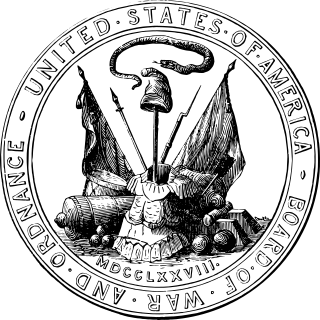
The Continental Army was the army of the United Colonies representing the Thirteen Colonies and later the United States during the American Revolutionary War. It was formed on June 14, 1775, by a resolution passed by the Second Continental Congress, meeting in Philadelphia after the war's outbreak. The Continental Army was created to coordinate military efforts of the colonies in the war against the British, who sought to maintain control over the American colonies. General George Washington was appointed commander-in-chief of the Continental Army and maintained this position throughout the war.

Timeline of the American Revolution—timeline of the political upheaval culminating in the 18th century in which Thirteen Colonies in North America joined together for independence from the British Empire, and after victory in the Revolutionary War combined to form the United States of America. The American Revolution includes political, social, and military aspects. The revolutionary era is generally considered to have begun with the passage of the Stamp Act in 1765 and ended with the ratification of the United States Bill of Rights in 1791. The military phase of the revolution, the American Revolutionary War, lasted from 1775 to 1783. A list of American Revolutionary War battles gives details.

The Second Continental Congress (1775–1781) was the meetings of delegates from the Thirteen Colonies that united in support of the American Revolution and the Revolutionary War, which established American independence from the British Empire. The Congress constituted a new federation that it first named the United Colonies of North America, and in 1776, renamed the United States of America. The Congress began convening in Philadelphia, on May 10, 1775, with representatives from 12 of the 13 colonies, after the Battles of Lexington and Concord.

John Dickinson, a Founding Father of the United States, was an attorney and politician from Philadelphia, Pennsylvania, and Wilmington, Delaware. Dickinson was known as the "Penman of the Revolution" for his twelve Letters from a Farmer in Pennsylvania, published individually in 1767 and 1768, and he also wrote "The Liberty Song" in 1768.
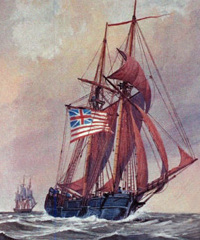
USS Wasp was originally a merchant schooner named Scorpion, built at Baltimore, and purchased under authority from the Second Continental Congress dated 2 December 1775 by Col. Benjamin Harrison sometime between 2 and 18 December 1775, the first US naval ship to be given that name. She was outfitted in Baltimore from December 1775 to early 1776; and commissioned in December 1775 or January 1776, Capt. William Hallock in command.
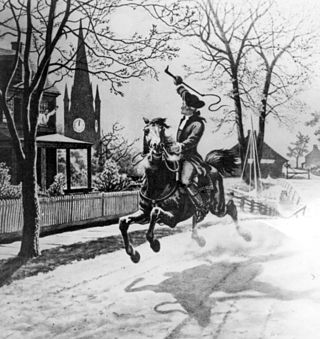
During the American Revolutionary War, the Continental Army and British Army conducted espionage operations against one another to collect military intelligence to inform military operations. In addition, both sides conducted political action, covert action, counterintelligence, deception, and propaganda operations as part of their overall strategies.
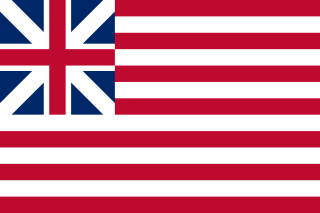
The Continental Union Flag was the flag of the United Colonies from 1775 to 1776, and the de facto flag of the United States until 1777, when the 13 star flag was adopted by the Continental Congress.
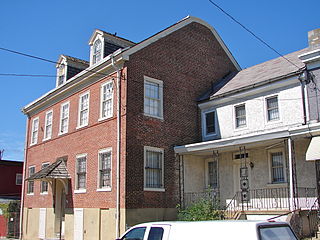
Frankford is a neighborhood in the Northeast section of Philadelphia situated about six miles (10 km) northeast of Center City. Although its borders are vaguely defined, the neighborhood is bounded roughly by the original course of Frankford Creek on the south to Castor Avenue on the northwest and southwest, to Cheltenham Avenue on the north, and to Aramingo Avenue and I-95 on the east. Adjacent neighborhoods are Bridesburg, Juniata, Northwood, Summerdale, and Wissinoming.
Daniel Roberdeau was an American Founding Father and merchant residing in Philadelphia, Pennsylvania, at the time of the American War of Independence. He represented Pennsylvania from 1777 to 1779 in the Continental Congress, where he signed the Articles of Confederation. Roberdeau served as a brigadier general in the Pennsylvania state militia during the war.
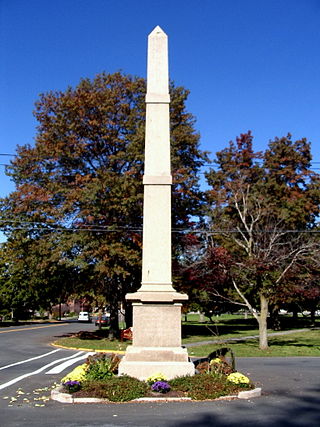
Henry Wisner was a miller from Goshen, New York. He was a Patriot leader during the American Revolution who, as a member of the Second Continental Congress, voted for Independence on July 4, 1776, at the creation of the Declaration of Independence. As a member of the First Continental Congress, Wisner signed the 1774 Continental Association.

William Montgomery was a colonial-American patriot, pioneer, soldier, public servant, and abolitionist.

Pennsylvania was the site of many key events associated with the American Revolution and American Revolutionary War. The city of Philadelphia, then capital of the Thirteen Colonies and the largest city in the colonies, was a gathering place for the Founding Fathers who discussed, debated, developed, and ultimately implemented many of the acts, including signing the Declaration of Independence, that inspired and launched the revolution and the quest for independence from the British Empire.

Carpenters' Hall, in Independence National Historical Park in Philadelphia, Pennsylvania, is the official birthplace of the Commonwealth of Pennsylvania and a key meeting place in the early history of the United States. Completed in 1775, the two-story brick meeting hall was built for and is still privately owned by the Carpenters' Company of the City and County of Philadelphia, the country's oldest extant craft guild.
Oswell Eve, sometimes referred to simply as Oswald, was a mariner, ship chandler, gunpowder manufacturer and member of the American Philosophical Society, in Philadelphia, Pennsylvania, elected in 1768. He attended the College of Philadelphia and was an associate of Dr. Benjamin Rush, later signer of the Declaration of Independence.

The George Taylor House, also known as George Taylor Mansion, was the home of Founding Father George Taylor, a signer of the United States Declaration of Independence, in Catasauqua, Pennsylvania in the Lehigh Valley region of eastern Pennsylvania. The home was built by Taylor in 1768 and designated as a National Historic Landmark in 1971.

Lydia Darragh was an Irishwoman said to have crossed the lines during the British occupation of Philadelphia, Pennsylvania during the American Revolutionary War, delivering information to George Washington and the Continental Army that warned them of a pending British attack. Contemporary sources claim Darragh's uncorroborated story is historically unsubstantiated.

A powder mill was a mill where gunpowder is made from sulfur, saltpeter and charcoal.

Major-General John Sullivan was a Continental Army officer, politician and judge who fought in the American Revolutionary War and participated several key events of the conflict, including most notably George Washington's crossing of the Delaware River. He was also a delegate to the Continental Congress, where Sullivan signed the Continental Association. After the war, he served as the third governor of New Hampshire and was appointed as a United States district judge of the United States District Court for the District of New Hampshire.
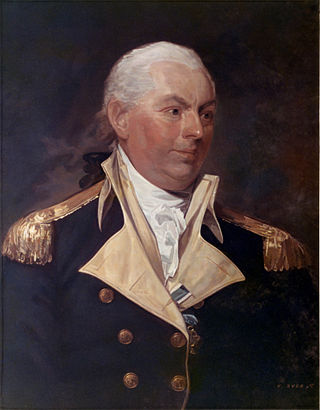
John Barry was an Irish-born American naval officer who served in the Continental Navy during the American Revolutionary War and in the United States Navy during the Quasi-War. He has been credited by some as "The Father of the American Navy", sharing that moniker with John Paul Jones and John Adams, and was appointed as a captain in the Continental Navy on December 7, 1775. Barry was the first captain placed in command of an American warship commissioned for service under the Continental flag. After the Revolutionary War, he became the first commissioned American naval officer, at the rank of commodore, receiving his commission from President George Washington in 1797.

The Continental Powder Works at French Creek is a historic gunpowder manufacturing complex in East Pikeland Township, Chester County, Pennsylvania. Constructed on French Creek in early 1776 and intended to supply the Continental Army during the American Revolutionary War, the mill was the only powder mill and gun factory commissioned by the Continental Congress. Designed to produce two tons of powder per week, the complex contained a dam, mill race, powder mill, graining mill, saltpeter house, four drying houses, powder magazine, a house for superintendent Peter De Haven, and barracks for militia guarding the facility. British troops burned the complex in September 1777, but the site continued to be used as a mill into the 1800s.
References
- 1 2 3 4 Salav, David L. (1975). "The Production of Gunpowder in Pennsylvania during the American Revolution". The Pennsylvania Magazine of History and Biography. 99 (4): 422–442. ISSN 0031-4587. JSTOR 20091001.
- 1 2 3 4 Auwarter, Barbara M.; Halley, Joyce (1990). "Frankford". Workshop of the World. Oliver Evans Press. Archived from the original on 2022-02-17. Retrieved 2022-10-05.
- ↑ Bell, Whitfield Jenks (1997). Patriot-improvers: 1743-1768. Philadelphia: American Philosophical Society. ISBN 978-0-87169-226-9.
- ↑ Farley, James J. (1994). Making Arms in the Machine Age: Philadelphia's Frankford Arsenal, 1816-1870. University Park, Pa.: Penn State Press. ISBN 978-0-271-01000-7. OCLC 27894635.